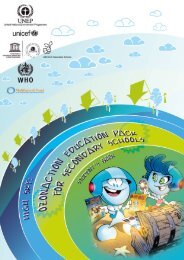Chapter 2. Progress towards the EFA goals - Unesco
Chapter 2. Progress towards the EFA goals - Unesco
Chapter 2. Progress towards the EFA goals - Unesco
You also want an ePaper? Increase the reach of your titles
YUMPU automatically turns print PDFs into web optimized ePapers that Google loves.
2<br />
0<br />
0<br />
1<br />
CHAPTER 2<br />
Box <strong>2.</strong>19: Rich countries — poor literacy<br />
Education for All Global Monitoring Report<br />
The world is far<br />
off track for <strong>the</strong><br />
2015 target of<br />
achieving a 50%<br />
improvement<br />
in levels of<br />
adult literacy<br />
This section focuses on illiteracy in poor countries,<br />
but rich countries also have significant pockets of<br />
deprivation. Many adults lack <strong>the</strong> functional literacy<br />
skills <strong>the</strong>y need to apply for jobs, read newspapers<br />
or understand documents — on housing, health<br />
and <strong>the</strong> education of children, for example —<br />
that affect <strong>the</strong>ir lives:<br />
In France, an estimated 9% of people aged 18<br />
to 65 lack <strong>the</strong> basic reading, writing, arithmetic<br />
and o<strong>the</strong>r fundamental skills required for simple<br />
everyday situations.<br />
In <strong>the</strong> Ne<strong>the</strong>rlands, 1.5 million adults (including<br />
1 million native Dutch speakers) are classified as<br />
functionally illiterate, implying that <strong>the</strong>y are not<br />
equipped to process basic information.<br />
In <strong>the</strong> United States, 14% of <strong>the</strong> population lacks<br />
<strong>the</strong> literacy skills to perform simple, everyday<br />
tasks like understanding newspaper articles and<br />
instruction manuals. Around 12% lack <strong>the</strong> literacy<br />
In Afghanistan, 87% of adult women and 57%<br />
of men were illiterate in 2000.<br />
In Chad, Ethiopia and Mali, women are around<br />
1.5 times as likely as men to be illiterate.<br />
In Algeria and Yemen, <strong>the</strong> illiteracy rates for<br />
females are more than twice those for men.<br />
Contrary to common understanding, <strong>the</strong><br />
relationship between average income and literacy<br />
is highly variable. For example, Egypt’s average<br />
income is comparable to that of Ecuador, but its<br />
literacy rate is 66% while Ecuador’s is 84%.<br />
Similarly, Algeria has a far higher level of average<br />
income than Bolivia but a lower adult literacy rate.<br />
In both cases, gender disparities explain much of<br />
<strong>the</strong> discrepancy (see annex, Statistical Table 2).<br />
The contrasting profiles for national literacy point<br />
to distinctive policy challenges. As well as making<br />
sure that young people emerge from education<br />
systems with basic literacy skills, many countries<br />
in sub-Saharan Africa, South and West Asia and<br />
parts of <strong>the</strong> Arab world need to extend literacy<br />
opportunities to a large share of <strong>the</strong> adult<br />
population. In Brazil and Indonesia, where<br />
illiteracy affects 10% or less of <strong>the</strong> adult population,<br />
policy-makers still have to address <strong>the</strong> task of<br />
reaching highly marginalized groups and people,<br />
many of <strong>the</strong>m in remote areas.<br />
skills needed to fill out a job application or<br />
understand labels on food and drugs. More than<br />
one in five — 22% of <strong>the</strong> population — has<br />
‘below basic’ quantitative skills, finding it impossible<br />
to balance a chequebook or deduce from an<br />
advertisement <strong>the</strong> amount of interest on a loan.<br />
In England (United Kingdom), 1.7 million people<br />
(5% of those aged 16 to 65) perform below <strong>the</strong><br />
level expected of 7-year-olds on <strong>the</strong> national<br />
curriculum test, and 5.1 million perform below<br />
<strong>the</strong> level expected of 11-year-olds.<br />
Literacy problems in rich countries are often<br />
concentrated in areas of acute social disadvantage,<br />
among migrant groups and <strong>the</strong> poor. Illiteracy<br />
is a factor in low pay, insecure employment<br />
and social exclusion.<br />
Sources: Burd-Sharps et al. (2008); National Agency to Fight<br />
Illiteracy (2007); National Literacy Trust (2009); Reading and<br />
Writing Foundation (2009).<br />
Measuring literacy is not an exact science. National<br />
estimates are typically derived from census and<br />
household surveys in which people are asked to<br />
report on <strong>the</strong>ir own literacy status (Box <strong>2.</strong>20).<br />
Because <strong>the</strong> idea of literacy is specific to different<br />
cultures and contexts, <strong>the</strong> word itself can have<br />
different meanings to different people (Fransman,<br />
2005; UIS, 2008a). National surveys often fail to<br />
generate representative data for populations that<br />
are hard to reach or people living in informal<br />
settlements (Aderinoye and Rogers, 2005). Given<br />
that literacy levels are likely to be lower among<br />
<strong>the</strong>se groups this can also lead to underestimation<br />
of <strong>the</strong> numbers of illiterates.<br />
The progress report<br />
The world is far off track for <strong>the</strong> 2015 target of<br />
achieving a 50% improvement in levels of adult<br />
literacy. In <strong>the</strong> absence of a concerted international<br />
drive to prioritize literacy, <strong>the</strong>re is little prospect<br />
of <strong>the</strong> target being brought within reach. Yet <strong>the</strong><br />
experience of some countries, and of some<br />
programmes within countries, demonstrates that<br />
a great deal can be achieved in relatively little time.<br />
Adult literacy rates in <strong>the</strong> developing world have<br />
been rising with every school generation. As more<br />
children enter school and leave with basic literacy<br />
skills, literacy rates inevitably rise. Literacy<br />
programmes have also played a positive role in<br />
some countries. From 1985–1994 to 2000–2007,<br />
96
















